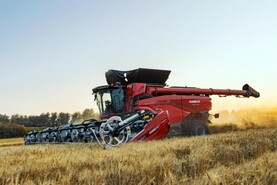Last week, as we baled the wheaten straw, the grass stopped growing. It is impossible to have weather that suits every enterprise and last week’s dry, settled spell was a godsend as we finished up the cereal harvest.
Every field of both seed and commercial wheat did comfortably over 4t in perfect conditions. Some of it busheled up to 83 KPH at moistures from 14% to 17%.
With two combines operating, our contractor had it all wrapped up by Wednesday afternoon.
I must admit I was tempted, with the price of fertiliser, to chop and plough the wheaten straw in.
However, a colleague did the sums and unless we were going to get a price for the carbon in the straw, we were still better off financially to bale it and sell it into the mushroom composting trade.
I presume as time goes on and carbon on farms becomes both measurable and valuable that the sums will change, but not this year.
The last thing we need is to bring a lot of cattle into the shed and run down our supply of silage
Having chopped the oaten and oilseed rape straw, we baled all the wheaten straw in the big 8x4x4 bales. So, much earlier than ever before, they are ready for stacking before moving off the farm.
However, the continuous dry high temperatures that made life so easy on the tillage side took its toll on grass growth.
I remember some years ago an Argentinian farmer telling me that five days of temperatures above 30°C will eliminate ryegrass from the sward. I am not sure whether that’s strictly true or not but it makes sense.
While we may not have got five continuous days above 30°C, the hot dry spell meant the regrowth from second-cut silage is non-existent and anywhere there has been tight grazing or the soil is shallow has become a parched brown.
At this stage I am still assuming that we will have enough grass to see us into November but with slightly more cattle on hand than normal, we will keep a close eye on it.
The last thing we need is to bring a lot of cattle into the shed and run down our supply of silage, which is already less than last year’s. We will certainly not be buying in any more stores for the moment.
The immediate task ahead is to prepare to get the oilseed rape into the harvested and stubble-tilled winter barley ground. After that the only crop left to harvest is the beans.
Again, the hot spell has accelerated ripening, so the question this year is whether we should, as usual, desiccate them in advance of harvesting.






 This is a subscriber-only article
This is a subscriber-only article










SHARING OPTIONS: